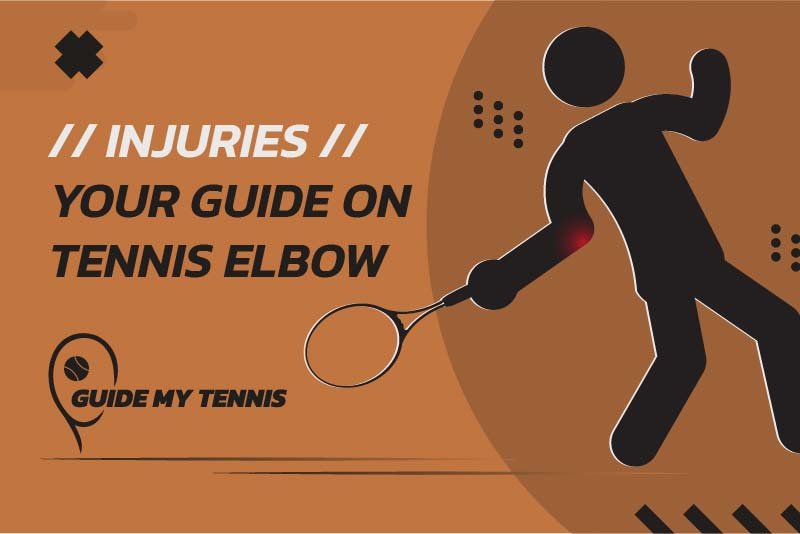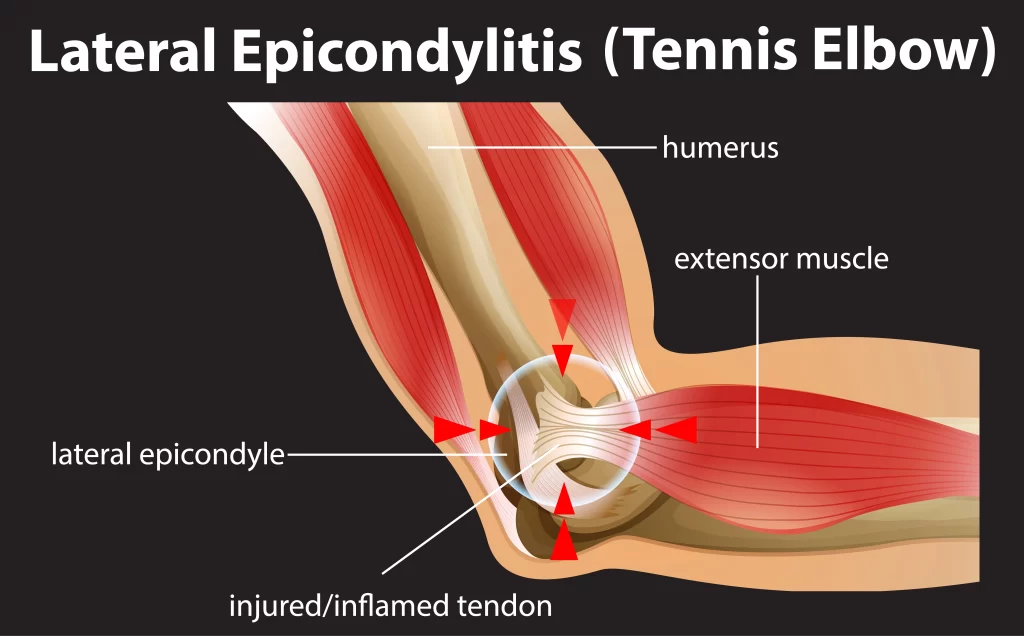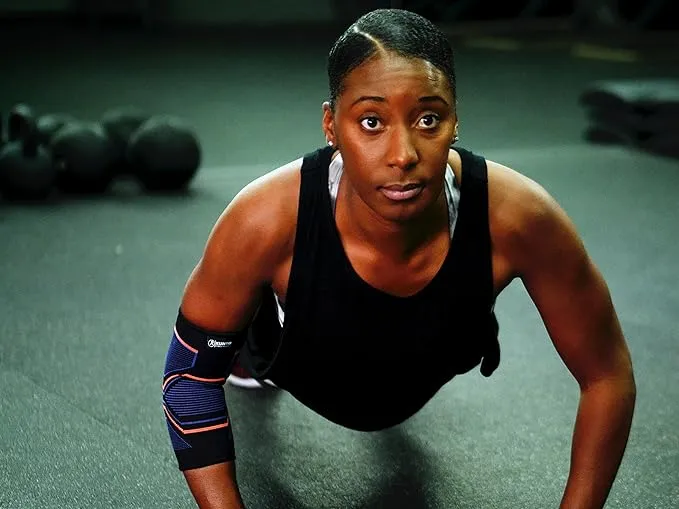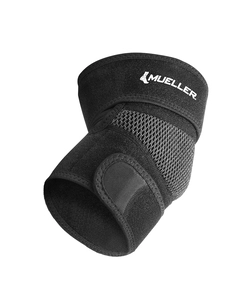Tennis Elbow Brace: Get Back in the Game Faster
In this blog, we will go over what tennis elbow is, what you can do to treat it and look at the best tennis elbow brace and straps available on the market.
Keywords: Tennis Elbow, Tennis Elbow Treatment, Tennis Elbow Brace, Tennis Elbow Support, Lateral Epicondylitis, Tennis Elbow Pain

Tennis elbow is one of those things that give us tennis players chilling nightmares. That soaring pain in your elbow might just be too much and may force you to take an unwilling break from tennis. But worry not, in this blog, we will go over what tennis elbow is, what you can do to treat it and even look at the best tennis elbow brace and straps that are available on the market.
What is Tennis Elbow?
Clinically known as Lateral Epicondylitis, tennis elbow is a syndrome that causes pain around the outside of the elbow when the tendons are overloaded. Other common names for this injury include Lateral Elbow, Epicondylitis or Tendonitis Elbow.
The pain associated with tennis elbow is generally located on the outside of the elbow. Pain tends to travel down the forearm since the tendons involved in this injury are located here. The injury comes from overusing these tendons, which may result in swollen or in some rare cases, even torn tendons. This pain can vary from mild discomfort to severe pain whilst the arm is being used.
Despite the name, this is a common syndrome that anyone can experience, even those who enjoy different sports, such as squash, badminton and swimming.

What are the Symptoms of Tennis Elbow?
Fair warning, tennis elbow symptoms are generally painful but may vary in the degree of pain. So in other words, not everyone gets the same tennis elbow. Symptoms and the associated pain may come out slowly and tend to worsen over time. With this being said, do keep in mind that no individual is alike and thus, not everyone can experience the same symptoms.
Here are some of the most common symptoms related to tennis elbow:
- Constant pain surrounding the outer elbow area that may travel down your forearms (these sensations may get worse at night).
- Pain when twisting or bending your arm – for instance when turning a door knob or swinging a tennis racket.
- Stiffness or pain when extending your arm.
- A weakened grip when you try to hold items like a mug, or a racket.
All these can result in having a swollen and tender elbow. However, these symptoms might occur due to injuries of other nature, so make sure to visit a medical professional to get a proper diagnosis.
What are the Causes of Tennis Elbow?
Lateral Epicondylitis is generally an issue which develops as a result of overusing a set of muscles that attach to your elbow. The said muscles allow you to twist and extend your forearm. The main cause for tennis elbow is repetitive tasks. This is commonly observed in those whose profession is carpentry, dentistry and painters who use brushes and rollers on a daily basis.
But as a tennis player, the main causes for tennis elbow include:
- Improper technique.
- Weak shoulder and wrist muscles.
- Using a tennis racket that is strung too tightly
- Using a tennis racket that is too heavy or too short.
- Hitting the ball off-centre on the racket, or hitting heavy, wet balls.
How do you Treat Tennis Elbow?
The good news when it comes to treating tennis elbow is that in most cases all you need to do is rest and it will automatically start getting better. One should only consider surgery in severe cases where pain becomes excruciating and other injuries might form.
Do note that symptoms may last for years, but a majority of those suffering from tennis elbow (circa 90%) claim to experience a significant improvement in 12 months or less after resting and refraining from taking part in strenuous activities.
Here are some minimally invasive tennis elbow treatment tips for dealing with this pain:
- Resting and stopping any and all activities that require excessive use that may enhance your symptoms, including tennis.
- Ice packs help reduce the inflammation around the tendons.
- Strengthening and Stretching Exercises (i.e. physical therapy).
- Anti-inflammatory medicine, such as Ibuprofen.
- Making use of a tennis elbow brace for support will help in putting less pressure on the affected tendons.
- Shockwave therapy – a relatively new method that breaks up damaged tissue and improves blood flow.
Additional Treatment Tips…
As a tennis player, another thing that you can do to help you minimise your pain is to consider making some changes to the racket and the tennis racket’s strings.
If a tennis racket is too stiff, you may find yourself putting unnecessary force on your arm if the frame of the racket is not so flexible. The anatomy of the tennis racket plays a crucial part on your injuries, do you have the right specs? Moreover, your tennis racket’s stringing will also affect the way you make contact with the ball and the vibration that goes through your arm. Do note that overall, polyester strings tend to be stiffer than synthetic strings. If you are reluctant to change your strings, you can also consider lowering the tension of your strings.
One can consider surgery if and only if none of the above help in any way whatsoever. If you are thinking of going down this path, make sure that you consult your medical consultant to discuss details.
How do you Prevent Tennis Elbow?
Getting to prevent a tennis elbow injury might not always be easy. If this is a work-related injury, make sure you adjust yourself accordingly to put as little stress as possible so as to help your pain get better.
Here are some tips to help you prevent and minimise tennis elbow pain:
- If you are experiencing pain, do not push through it – this is your body telling you that you are already exceeding the limit and that you should stop. Always listen to what your body is saying!
- Check your racket! Make sure your tennis racket is not strung too tight or too heavy for you. Here’s a guide on how to choose a tennis racket for yourself.
- Strengthen your forearms and wrist muscles through physical therapy.
- Warm up properly before engaging in physical exercise.
- Avoid repetitive strenuous movement.
- Don’t stiffen your arms and keep them flexible.
- Wear a tennis elbow brace for further support as this will help put less pressure on the affected tendons.
What is the Best Tennis Elbow Brace?
If you suffer from tennis elbow, chances are that you will be viewing some of these products. Now, a word of advice before venturing forward – Note that this piece of gear varies between one manufacturer and the other. So what is suitable for me may not be as suitable for you. Therefore, please make sure to do your own research when attempting to purchase a tennis elbow brace.
When it comes to tennis elbow braces, there are a total of three different kinds:
- Sleeve Elbow Brace
- Strap Elbow Brace
- Dual Support Elbow Brace
Sleeve Tennis Elbow Brace
The sleeve brace is a piece of clothing that is lightweight and can be easily worn by sliding your arm into it. Since this brace comes in the shape of a sleeve, you are bound to find it the most comfortable when compared to the strap and dual support braces since the sleeve elbow brace is the least bulky of all.
The DashSport Tennis Elbow Brace is one of the best sleeve braces there is on the market. Unlike other sleeve braces, this DashSport brace comes with a strap as well, making it a hybrid of the sleeve elbow brace and the strap tennis elbow brace. As a brace, it is made out of a breathable material and stays secure and comfortable around your arm.

Another sleeve tennis elbow brace available on the market is the Kunto Fitness Elbow Brace Compression Support Sleeve. This brace provides solid all-round support and helps particularly well with joint stability. However, some people prefer to go for the bulkier strap or dual support tennis elbow braces since these are more suited for acute elbow pain than the Kunto Fitness Elbow Brace
Strap Tennis Elbow Brace
The strap elbow brace supports your arm better since this makes utilises a single or a pair of velcro straps. These tend to be a bit bulkier and are slightly harder to wear. But hey, this is not a fashion show and support should always be chosen over fashion!
The Bodyprox Elbow Brace is a popular choice for many people. This is a budget-friendly strap brace that serves its purpose well and helps many users recover well. This strap brace, like many others, comes with an adjustable velcro strap.
Another popular choice is the Rolyan Neoprene Tennis Elbow Strap. Just like the previous brace, this is also a budget-friendly brace, has a classic design and protects your elbow and its tendons from any extra force being made.
Dual-Support Tennis Elbow Brace
Lastly, there is the dual-support tennis elbow brace. Such a brace offers the best support. It is constructed through straps that are connected on either side of the elbow. Dual-support braces are designed to help you limit your movement so as to not risk making the injury worse, thus, allowing you to keep playing tennis.
The Mueller Adjustable Elbow Support is a top-of-the-range dual-strap tennis elbow brace. Like many other braces, this one helps with the prevention of hyperextension and provides a comfortable fit.
However, this brace is a bit restrictive as it does not fit people who have an elbow that is bigger than 14 inches/35 centimetres in circumference.
If you want more injury-related content, I suggest looking at these 5 ways to relieve yourself from lower back pain. For other tennis-related content, don’t forget to check out Guide My Tennis


